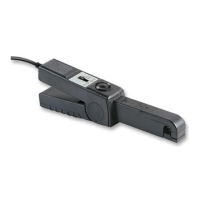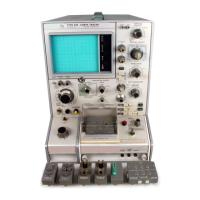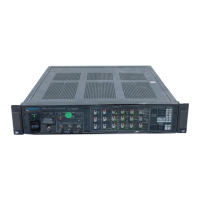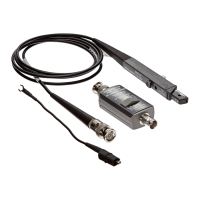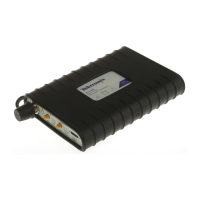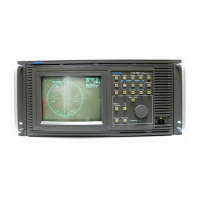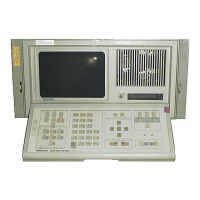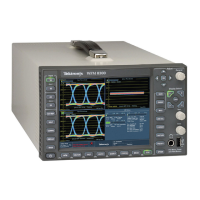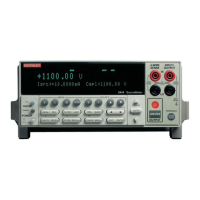Operatlng Instructions-AA
501
LED goes out. If the DECREASE RANGE LED is il-
luminated, turn the INPUT LEVEL RANGE control
counterclockwise to a lower range until the DECREASE
RANGE LED goes out. For specified instrument accuracy
adjust the INPUT LEVEL RANGE as just described.
However, readings are usable as long as the display is not
overranged. Overrange is indicated by a blank display with
the numeral 1 in the most significant digit slot. If the
INPUT LEVEL RANGE switch is placed in the AUTO
RANGE position, the input level adjustment is ac-
complished automatically. The
LED'S (VOLTS, mVOLTS
or pVOLTS) automatically illuminate showing the proper
display units. Notice that the three most sensitive ranges
on the INPUT LEVEL RANGE control operate in the
LEVEL FUNCTION only.
When the
dBm 600
f2
pushbutton is pressed, the LED
opposite
dBm on the display indicates the display units.
The reference level for this measurement,
0 dBm, is 1 mW
dissipated in 600
f2.
This is equivalent to 0.7746 V rms
developed across a 600
C2
resistor. The INPUT LEVEL
RANGEswitch operates in thesamemanner as previously
described.
The dB RATIO mode permits direct ratio meas-
urements of two input signal amplitudes. When the dB
RATIO pushbutton is pressed, the LED opposite the dB
nomenclature on the display is illuminated. To use this
feature, press the dB RATIO pushbutton. To establish the
input signal as
0 dB reference, push the PUSH TO SET
0 dB REF pushbutton and notice that the display reads all
zeros. As the amplitude of the input signal is changed, the
display will read the dB ratio of the input signal to the
reference signal amplitudes.
There are many useful applications for the dB RATIO
mode in measurements of gain-loss, frequency response,
S/N ratio, etc. For example, the corner frequency of a filter
may be quickly checked. Set the test frequency to some
midband value and set the zero dB reference. Adjust the
test frequency until the display reads -3.0 dB; this is the
corner frequency of the
fllter.
Gain measurements may be similarly simplified by
using this feature. Set the device to be tested as desired
and connect the AA 501 input to the input of the device
under test. Press the PUSH TO SET
0 dB REF pushbutton.
Connect the input of the AA
501
to the device output and
read the gain or loss directly from thedisplay. When using
the SG 505 oscillator and the TM 500 rear interface
feature, changing of external connections to establish the
0 dB input level reference is not necessary. Interconnect
the Buffered Main Output of the SG 505 and the rear
interface input of the AA 501. Pressing the REAR
INTFC
pushbutton will conveniently allow direct measurement of
the signal level going to the input of the device under test.
When measuring signal to noise ratio or making noise
level measurements, it is often desired to employ a
frequency dependent weighting network. The AA 501
provides several internal filters as well as facilities for
connecting external filters. For information on their
operation and use, see the text under Filtersin thissection
of the manual.
Dlstortlon Measurements
Distortion is a measure of signal impurity. It is usually
expressed as a percentage or dB ratio of the undesired
components to the desired components of a signal.
Harmonic distortion
issimply the presence of harmonical-
ly related or integral multiples of
a
single pure tone called
the fundamental, and can be expressed for each particular
harmonic. Total harmonic distortion, or THD, expresses
the ratio of the total power in all significant harmonics to
that in the fundamental.
A distortion analyzer removes the fundamental of the
signal to be investigated and measures the remainder. See
Fig.
2-4. Because of the notch filter response, any signal
other than the fundamental will influence the measure-
ment.
A
total harmonic distortion measurement will
inevitably include effects from noise or hum. The term
THD+N has been recommended' todistinguish distortion
measurements made with a distortion analyzer from those
made with a spectrum analyzer. A spectrum analyzer
allows direct measurement of each harmonic. However, it
is relatively complex, time consuming, and requires
interpretation of a graphic display.
All distortion analyzers are limited ultimately by their
internal distortion and noise. Traditionally, distortion
analyzer residual noise and distortion have been specified
separately. However, because an actual measurement
always includes both effects, both residuals must be
combined to determine the minimum valid reading. For
example, an analyzer rated at 0.002% residual distortion
and 0.002% noise may exhibit a
THD+N reading of
0.0028% and still be within specification. Also, average
responding analyzers may read up to
25% lower than true
rms responding analyzers. The AA 501 specifies the
combined residual effect with rms response and offers
selection of rms or average response.
Distortion analyzers can quantify the nonlinearity of a
device or system. The transfer (input vs output)
characteristic of a typical device is shown in Fig. 2-5.
Ideally this is a straight line. A change in the input
produces a proportional change in the output. Since the
actual transfer characteristic is nonlinear, a distorted
'
IHF-A-202 1978. Standard Methods of Measurement for Audio
Ampllflers. The Institute of High Fidelity, Inc., 489 Fifth Avenue.
New York, N.Y. 10017
ENGLISH
2-6

